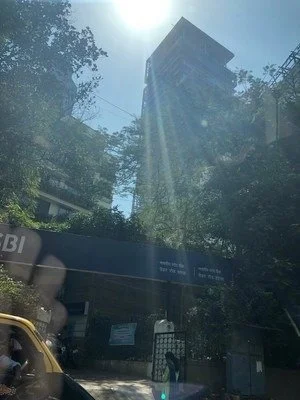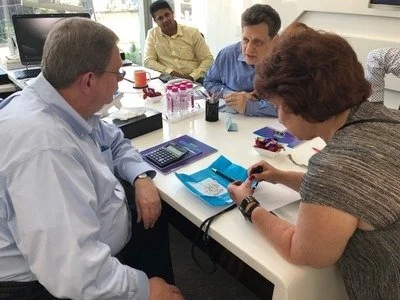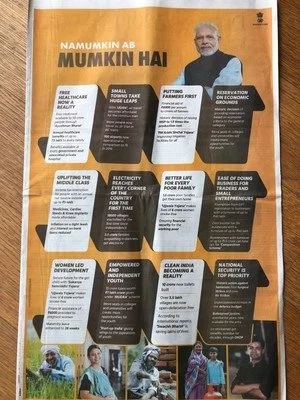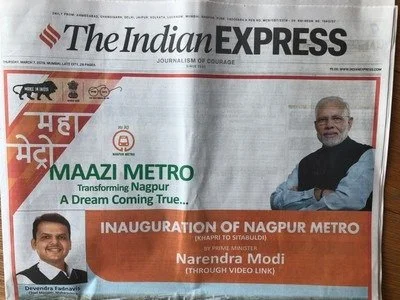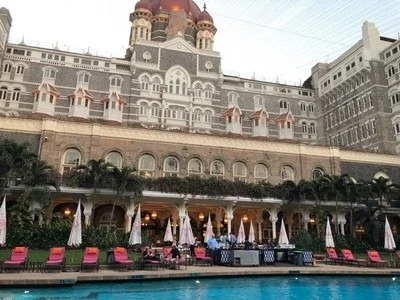Mumbai Money
Nonstop. Our flight and our lives.
08.03.2019 - 08.03.2019 80 °F
In his book, The Portuguese, A Modern History, Barry Hatton writes of the “discovery” of Mumbai, this harbor city, by Vasco da Gama in 1497. “The Portuguese came across a wonderful natural harbor on the Indian coast which they called bom bain, meaning “good little bay” in sixteenth-century Portuguese. The Portuguese later gave the settlement to the English who anglicized its name, making it Bombay.”
Centuries later, in 1995, the Indian government officially changed the English name to Mumbai after a political movement to strengthen the ethnic Marathi identity demanded it. Some argued that Bombay was just a corrupt English mangling of the name Mumbai and served as a reminder of the despised legacy of colonial times. Regardless, the three-letter airport designation for Chhatrapati Shivaji Maharaj International Airport where we landed remains: BOM.
Home to a metropolitan area population of over twenty-one million people, it is the capital city of the Indian State of Maharashtra where the “highest number of Indian millionaires and billionaires” reside and where one of the largest slums in Asia, Dharavi, is located. Seven islands in the natural deep harbor make up the city which was the original home of the ethnic Koli people.
As I am with Aashish and overhear him arranging this and that for us, I hear him switching languages mid-sentence. English is spoken here but the official language of the state is Marathi. Of course, Hindi is widely spoken but, I am told, so is Gujarati, Kannada, Telugu, Konkani, Dangii and Varhadii. Aashish tells me his “switching” is mostly between English and Hindi with a bit of Marathi thrown in, depending upon to whom he is speaking.
The world’s second most expensive home is located here and we drive by it often (the most expensive, according to Architectural Digest, is Buckingham Palace). It is owned by our groom’s father, Mukesh Ambani. The 400,000-square-foot “$1-2 billion Antilia” on Mumbai’s Cumballa Hills’ Altamount Road has been passed by but not visited by us several times on this trip. Six of its twenty-seven floors are dedicated to garaging a fleet of automobiles. Chicago-based architects Perkins and Will designed it to include three helipads, Australian construction company Leighton Holdings built it and a staff of 600 maintain it. It was formerly the site of the Currimbhoy Ebrahim Khoja Yateemkhana Muslim orphanage and the land’s acquisition was said to have been illegal pending a still active court case.
Ambani is said to have not yet moved into the high-rise structure, allegedly because the building doesn’t conform to the ancient doctrine of Vastu Shastra which caters to the importance of “directional alignments to create spiritual harmony.” That may be idle gossip—in this day and age who knows? Hillary Clinton reportedly attended one of the many functions of Akesh’s sister Isha’s wedding that was held at Antilia in December.
Here, destitution and opulence compete but neither vanquishes the other. In India, you can simply soak in the chaos while you ponder it. The wealth gap here is pronounced, visible and assaulting. People's money and the lack of it drive my perception of the place. I ramble too much in the next many paragraphs because wealth here conflicts me. I hope you will tolerate and forgive as I write too much. Should you wish, skip ahead; you will have lost only my bewilderment at the reality of India.
What of the economic arguments currently offered by U.S. politicians Bernie Sanders, Elizabeth Warren and Alexandria Ocasio-Cortez? They offer sketchy plans to tax extremely high levels of earned income at much higher levels and tax already amassed vast wealth of the super-rich. If these plans are to punish the wealthy, then I reject them. If they are to aim at perpetuating and advancing while enhancing a civil society then I think they must be the source of analytical thinking and perhaps endorsement.
“Abolish Billionaires” is an argument that is, I think, poorly stated and most certainly stupid. Princeton University moral philosopher Peter Singer’s book, “The Life You Can Save,” offers the idea that the rich should be doing more to improve those who are mired in extreme poverty. To me, that is obviously true. But the question must become: should that philanthropy be voluntary or mandatory?
I suppose that, at some point, one has more money than one can ever spend, and, at that point, the amassing of even more money is about the ego exercise of getting your name higher on the “wealthiest persons” list than anything else. “Look at me,” one might say, “I am the world’s richest person.” The Sanders-Warren-Ocasio-Cortez philosophy, if only it could be properly framed by someone savvier than they might instead be, “Look at me, I am the world’s most generous person, doing the most good for humanity.”
It is estimated that there are 2,200 billionaires in the world. Five hundred of them are in the United States. Just under 200 of them have signed “The Giving Pledge” created by B4’s Warren Buffet and Microsoft’s Bill and Melinda Gates. But, it is also significant to me that the “Pledge” distributes their money only after they have held onto it for longer than they could have ever made use of it, negating the work it might have done if philanthropically distributed earlier.
I have always believed that money in circulation is “good” while money amassed in sums beyond a plan to deploy it is “bad.” It is bad because, without deployment, money does no good but sooth the anxious ego.
The wealth gap in this nation and at home in America may very well one day backfire on us. A “French Revolution” could and will again occur when those with nothing are taunted by a social media frenzy quoting the “Let them eat cake” perceived or real insensitivity of the super-rich. It is inevitable.
When one’s basic human needs are unmet and one is armed, violence will follow. That violence will be targeted at the perceived source of selfishness that one blames for one’s suffering.
The argument becomes: if the billionaires of the world won’t give their money away, should we then take it (tax it) away? That answer must be, as one of my classes on ej4 opines: “No, But, If.” “No. But, their wealth will grow even larger if they spread it around and, by having done so, it comes back to their businesses and investments in even greater amounts.” Wash, rinse, repeat.
As more people have more disposable income, business and industry thrive because they sell more goods and services in exchange for that disposable income. The employees and shareholders of those businesses ultimately benefit because they do more business. Ours is a consumer society where one becomes super-rich by selling other people more things to consume. Those things bring them happiness (if consumed in moderation) and the wheels on the bus go round and round and round.
B4 and I are off to the HDS office. There is always work to be done, employees to be made to feel proud and a valued part of the team and stones to be seen. We meet with Bobby and Boris and Vaibhav and Scott and others discussing strategy and plans and tactics galore. Our wedding venue is just off the office balcony and preparations are hectic. Money is being spent and that is a wonderful thing because that's all its good for.
Selfishly, I want the billions to come out of storage and into use. If only we could, as a society, begin to admire, even if grudgingly, those who spend (and thereby spread) their wealth rather than hoard it.
To come full circle, I applaud the spending of $100 million on a wedding and on a bachelor party in St Moritz for 500 because those events require that money be put into circulation rather than hoarded. It ultimately goes into the pockets of working people who then spend it to, first, satisfy their own basic needs and, second, spend it on some luxury of their own choosing.
So, “eliminating billionaires” (which shouldn’t really happen) in this way creates hoards of “thousandaires.” That, I proffer, is a better thing for everyone. Economic inclusion just might facilitate racial, ethnic and religious inclusion. Fear and hate would then atrophy along the way because there is no group to envy or blame. More jobs mean more earned income, less crime and more happiness.
“We hold these truths to be self-evident, that all men are created equal, that they are endowed by their Creator with certain unalienable Rights, that among these are Life, Liberty and the Pursuit of Happiness.” If only there were words surrounding that adding something about “certain unalienable Responsibilities, that among these are philanthropy, even if selfish.”
So, it is with great honor that we, B4 and I, are at the wedding of Shloka Mehta (Ambani) whose mission in life is not diamonds or wireless communications or real estate. Her mission is Philanthropy. You go Shlo. Akash, keep making money so she can use it to make the world a better place. That is what capitalism, when it is at its best, must and can do.
So, this India that we visit is a fascinating, confounding and mysterious place. Nine hundred million Indians are under the age of 35. For reference, the entire population of the United States is but 325 million. Let that sink in for a moment. Think of the number of new jobs that must be created each year to support the vast numbers of young people entering the job market--at a vastly greater velocity than older people leaving it. Why do we obsess about growth? That’s why; our population is growing.
A recent study described India’s economic situation thusly: “India’s new “lower-middle” class lives on $2-$4 per day (vendors, maids, carpenters), the “middle-middle” class is anyone living between $4-$6 a day while the “upper-middle” is categorized as anyone living between $6-$10 a day. “Affluent” are categorized as anyone living on $10 or more a day. Now let that sink in for a moment.
One cannot, of course, relate these figures to the cost of living in the United States. In India, a monthly high-speed data smartphone plan costs as little as $2.25. However, the McKinsey Global Institute says that if India continues on its current trend line, average household incomes will triple over the next twenty years making the country the world’s fifth-largest consumer economy. That means more people with discretionary income able to buy more non-necessity items.
But, today, more than half of India’s population depends, as in former times, on agriculture to survive. Under a new tax proposal here, small-scale farmers would receive annual supplemental payments of about $85, equivalent to “about a month’s earnings.” Reports indicate that “thousands of farmers, despondent over dwindling yields and seemingly endless bills, commit suicide.” This distress is caused by a variety of factors, among them shrinking plots of land, high prices for fertilizers and climate change.
To supplement the cost of their survival, rickshaw pullers, bricklayers, tea sellers, maids, drivers, watchmen and millions of others are also slated to receive government bonuses under the plan.
The ubiquitous wealth dichotomy is nothing less than stunning.
Indian President Narendra Modi was elected five years ago and is up for reelection in balloting the New York Times reports is “likely to be held by early May.” For foreign visitors, election season always adds potentially sensitive drama, particularly so in a nation the size and complexity of India. This vote was recently considered, “A walk for Mr. Modi (but) now seems too close to call.”
This is in a country where, in the last election, more than a dozen political parties elected Parliamentary representatives divided by region, religion or caste. No party will, it is predicted, win the outright majority vote needed to control Parliament forcing strategic alliances to be made. Yet, still, I read that the old adage is perhaps certain: “Indians don’t cast their vote, they vote their caste.”
The 3,000-year-old caste system was banned my lifetime ago soon after India’s independence from the United Kingdom in 1947. Stemming from original Hindu teaching, the system divided Hindus by occupation with priests and scholars at the top followed by warriors, traders and laborers and finally by untouchables—night soil workers. For 72 years the system is claimed to be dead. I cannot know the truth of this and our surroundings call it into question.
Remarkably, In November 2016, the current government moved to eliminate not caste but cash. Called “demonetization,” the move was designed to crack down on “illicit cash transactions.” Six months later, the government implemented a single tax: the “Goods and Services Tax.”
Arguments leading up to the election abound: is the current unemployment rate skyrocketing to 6.1% or not, is the economy enjoying robust growth at 7% or not? One disputed report says unemployment is at a 45-year high. Another says it is not. But, understand that with the rapidly growing population, India needs to create 1,000,000 new jobs every month just to keep up.
Meanwhile the Indian government has proposed Chinese style internet content restrictions, banning posts or videos that are deemed “libelous, invasive of privacy, hateful or deceptive.” On the other hand, the Indian Supreme Court belatedly but laudably decriminalized homosexuality last year.
According to the U.S. Department of State, “Indian authorities report rape is one of the fastest growing crimes in India. Violent crime, such as sexual assault, has occurred at tourist sites and in other locations.” British Broadcasting Company reports that male Hindu College students in Delhi hang condoms filled from water from “The Virgin Tree” and then pray for virginity ending “curvaceous goddesses” to appear…within six months. Female students protest this ritual.
The U.S. State Department also reports, “Terrorist or armed groups are active in East Central India, primarily in rural areas.” In February, 40 or more Indian forces were killed in a suicide attack in India-administered Kashmir—an area Pakistan describes as “Indian Occupied.” The air force skirmish I wrote about in an earlier post resulted in the aftermath.
For your reference, wedding site Mumbai is located far from there on India’s central west coast. Nonetheless, we are warned that security will be tight. We seem armed guards, both in and out of uniform, with advanced weaponry at the ready. As recently as last Monday morning, we were again requested to “urgently” send copies of our passports and Indian visas to the wedding organizers for, we assume, security purposes. (I had already sent them but re-sent them regardless)
We have RFID wristbands for ourselves and cards for our driver’s car for admission. We will carry copies of our passports and visas as well.
When they scan these wristbands, they look up and call us by name. That's a new experience for us.
And, if all of that were not enough, amazingly, Science Magazine reported in February that since 2014, Hindu nationalism here is on the rise. “Experts” supporting that native pride have been telling the uneducated and ill-informed populace that Indian scientific advances preceded those of the west. Evidence of the fact is that the internet, spacecraft and nuclear weapons existed in India in ancient times, long before their supposed discovery by western cultures centuries later. Fake News? Ah, one supposes so.
Tonight we dine at the Taj Palace. We are exhausted and I drift in and out of sleep at the dinner table as the unforgiving reality of an 11.5 hour shift in my body clock relentlessly reminds me that it may seem to be one time while it is actually quite another.
We walked through downtown Mumbai this afternoon with a guide. The cacophony and chaos of the place envelopes you. Tuk Tuks (three wheeled mini-taxi-type scooters) race here and there dodging motorbikes and vehicle taxis. Some traffic signals are referred to by our guide as merely "suggestions." A symphony of horns assaults you and, eventually, becomes simply background noise, honks to be ignored as they become ubiquitous. It is hot but not too hot; everyone comments that the weather is quite mild. We eat Chinese food for both lunch and dinner because we know what it is. We consume no ice in our drinks. We are mindful of our surroundings; I keep nothing in my back pockets. Women are colorful, always dressed to the nines. Men dress in black and white, mindless of how they look in their short sleeve white shirts and dark trousers. Street vendors abound, food is cooked, sugar cane water is offered for sale, freshly squeezed, phone cases and socks and books and more are offered to everyone who passes but most don't buy.
As the wedding is now upon us, we absorb it all with the clear and stark realization that we aren't in Kansas any more.
